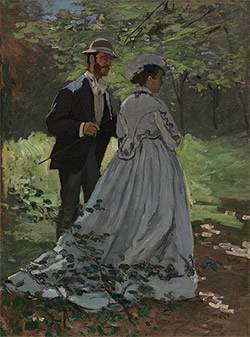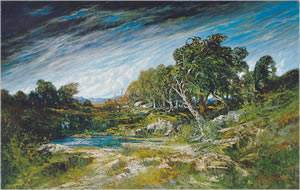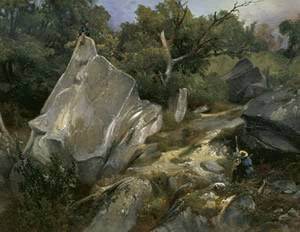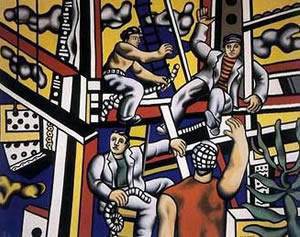
Claude Monet
Bazille and Camille (Study for “Déjeuner sur l’herbe”), 1865
National Gallery of Art, Washington

Gustave Courbet
The Gust of wind, c. 1865

Augustin Enfantin
An Artist Painting in the Forest of Fontainebleau , c. 1825
Private Collection
Plein-Air Practice In The Forest Of Fontainebleau
National Gallery Of Art, Washington, March 2 -June 8, 2008
]]>
The quiet but significant revolution that was launched by artists working outdoors in 19th-century France is explored through some 100 paintings, pastels, and photographs as well as artist and tourist ephemera assembled for the exhibition In the Forest of Fontainebleau: Painters and Photographers from Corot to Monet at the National Gallery of Art, East Building, from March 2 through June 8, 2008.
Works by artists such as Jean-Baptiste-Camille Corot (1796-1875), Théodore Rousseau (1812-1867), Jean-François Millet (1814-1875), Claude Monet (1840-1926), and photographer Eugène Cuvelier (1837-1900) will showcase the French phenomenon of plein-air (open-air) painting in the region of Fontainebleau, which became a pilgrimage site for aspiring landscapists. Spanning half a century, from the mid-1820s through the 1870s, this artistic movement gave rise to the “Barbizon School” and laid the groundwork for impressionism.
“This exhibition celebrates a fertile relationship between artists and a unique locale that had a critical impact on European and American artists, such as the impressionists, in the decades that followed,” said Earl A. Powell III, director, National Gallery of Art. “We are grateful to the many public and private lenders and especially would like to thank the Florence Gould Foundation for its support and its continuing commitment to the National Gallery.”
In the Forest of Fontainebleau is organized by the National Gallery of Art, Washington, in association with the Museum of Fine Arts, Houston, where the exhibition will be on view July 13 through October 19, 2008.
The Exhibition
From plein-air sketches to impressionist canvases, the exhibition traces the centrality of the Forest of Fontainebleau in the development of naturalistic landscape painting in the 19th century. In addition to paintings, pastels, and photographs, In the Forest of Fontainebleau includes popular 19th-century guidebooks, maps, and souvenirs that reflect Fontainebleau’s history as a tourist destination.
An installation of 19th-century photographic equipment as well as open-air painting gear will be displayed near the entrance to the exhibition.
The exhibition is organized in six sections:
Discovery of the Forest: Artists first began visiting the forest in the 1820s. Having adopted the practice of painting outdoors while studying in Italy, these early visitors sought a similarly inspiring place in France to learn directly from nature. In 1822, Corot discovered Fontainebleau, where he created some of his first open-air studies and returned repeatedly over the next five decades. In Le Rageur, Forest of Fontainebleau (c.1830), Corot depicts a favorite motif of the painters in the forest: a twisted, knotty oak tree nicknamed “the raging one.” Beginning in the late 1840s, photographers seeking to reveal nature in a fresh and unadorned manner, joined the ranks of painters who made seasonal pilgrimages to the forest. Like their fellow painters, photographers captured the transitory effects of light and shadow as well as seasons and weather in images like Study of Trees and Pathways (1849) by Gustave Le Gray (1820-1884).
Trees and Rocks: Fontainebleau differs from other French forests in size, the extraordinary variety of its vegetation, the unusually rugged topography (especially the massive rock formations), and the remarkable number of trees, including beech, hornbeam, and the forest’s great pride, oak. Renowned for her animal paintings, Rosa Bonheur (1822-1899) visited Barbizon in 1853 and eventually settled permanently in the village of Thoméry. In one of her rare pure landscapes, Forest of Fontainebleau: Spring in the Woods (1860-1861), she depicts a vibrant, meticulously detailed view of trees in the forest. Cuvelier, who studied landscape painting as a young man, photographed the forest in all seasons. In Franchard (1863), he depicts a single figure atop the infamous rocky plateau considered among the most savage and desolate places in the forest.
Nature and Observation: By the 1830s a new generation of artists, who had not made the pilgrimage to Italy, began to gravitate to the forest of Fontainebleau. Chief among them was Rousseau, who was a regular visitor to the forest throughout the 1830s and 1840s before settling there, and was perhaps most obsessed with conveying its many moods. Rousseau painted Jean de Paris, an area known for its stark plateaus and rough terrain, many times in diverse weather, including fog, rain and snow, and at varying times of day, as seen in his Sunset over the Sands of Jean de Paris (1864). This desire to capture the ephemeral effects of nature was a hallmark of the movement that came to be known as the Barbizon School.
Fontainebleau on a Grand Scale: Although many artists enjoyed the freedom of making small scale studies, the Forest of Fontainebleau also was the subject and inspiration for monumental paintings, many of which were produced in the studio after studies, drawings, and even photographs made on site. Although based in part on sketches of Fontainebleau, The Gust of Wind, (c. 1865) by Gustave Courbet (1819-1877) is a fantasy landscape combining different elements of the forest rather than a depiction of a specific view. The largest of his pure landscape paintings (57 3/4 by 90 7/8 inches), it stands as a prime example of the artist’s virtuoso technique.
Village Life: The villages surrounding Fontainebleau were rural communities that depended on the cultivation of crops planted in the adjoining plains. For painters and photographers who took up lodgings in the villages, the daily life of peasants going about their routine-farmers planting in the fields, shepherdesses tending their flocks, and laborers at work and rest-provided an endless source of themes. While attracted to the picturesque qualities of rural life, some artists were also aware of its demanding conditions, as suggested by Millet’s The Shepherdess (1870) and Auguste Giraudon’s Artist’s Peasant (c. 1870).
Sites of Renown: The northwest region of the forest was the area most often frequented by tourists and artists, benefiting not only from the proximity of the nearby villages of Barbizon and Chailly but also from the wealth of extraordinary sites such as the Pavé de Chailly, Carrefour de l’Epine, and Bas-Bréau. When Frédéric Bazille, Claude Monet, Auguste Renoir, and Alfred Sisley traveled to Fontainebleau together in the 1860s, they sought out many of the same areas that had attracted painters they admired. Adopting a brighter palette than their predecessors, they focused on the play of light, shadow, and reflections in the forest, in the process developing the basic vocabulary of impressionism. In his painting of one of the most famous trees in the Bas-Bréau, The Bodmer Oak, Fontainebleau Forest (1865), Monet concentrated fully on the effects of sunlight falling through the trees.
Follow us on:


